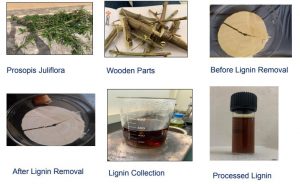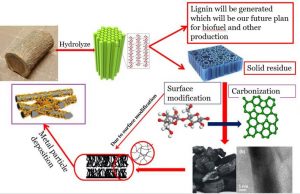Design and Development of High Energy Ethanol Fuel Cell from an Aggressive Invader Prosopis Juliflora to Mitigate the Challenges of Global Warming and Green House Gases
Introduction: Energy demand is exponentially increasing, and fossil fuels are overconsumed, which impacts biodiversity negatively. Moreover, the scarcity of groundwater is increasing day by day because of the abnormal growth of an invasive plant called Prosopis Juliflora.
There is a need to develop renewable green energy that can maintain biodiversity, reduce pollution, and have a positive impact on the environment. Ethanol-based proton exchange energy storage devices are known for their high specific energy density (8.0 kWh/kg for ethanol and 6.1 kWh/kg for methanol), low toxicity (compared to methanol), and hydrogen-rich molecules. Interestingly, it is easy to reproduce from waste material with a low cost of production.
We propose a novel method of converting an insidious Prosopis Juliflora source to develop a Direct Ethanol Fuel Cell (DEFT). Basically, low tortuosity and regular porous structures are the main benefits of the ethanol fuel cell. We have done carbonization and activation at low temperatures to improve the electrical conductivity of 3D carbon. Then uniform deposition of metal nano-particles by electrochemical deposition methods will be done. The synthesised material will be used to fabricate fuel cells.
Main outcomes
- Development of a renewable ethanol fuel cell to reduce greenhouse gases less than fossil fuel combustion engines
- Control and utilisation of an invasive plant to save groundwater and resurrect the eco-system of agricultural lands
- We can get some essential bi-products during the process of making ethanol fuel cells:
- Extracted lignin from the wooden pieces of the Juliflora has good potential to be used as bio-fuel.
- The generated ethylene glycol has many industrial applications that can be generated from this species instead of using petroleum products.
- The pods of Prosopis Juliflora contain a huge amount of sugar that will generate ethanol.
- Experimental procedure
Material Required: For primary development: sodium hydroxide, hydrogen peroxide, sodium potassium tartrate, sodium hydrogen carbonate, palladium chloride, tin chloride, chunks of wood
Experimental Procedure
Experimental Procedure:To get the desired efficiency, the lignin is removed from the cell wall of wood. Then carbonization will be done in the presence of argon and hydrogen in an atmosphere at 11000 °C for 4 hours. Further, it will be activated in the presence of sodium potassium tartrate and sodium hydrogen carbonate at 4500 °C for 4 hours. This activated carbon will be stored for binary metal particles by electrochemical deposition. We will fabricate a cell using Nafion membrane, whereas one side is metal nano-particle decorated 3D-carbon and the other side is porous high-conducting carbon.






